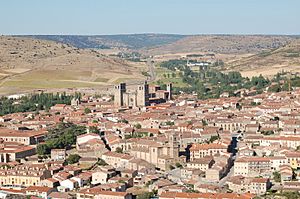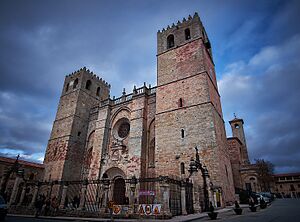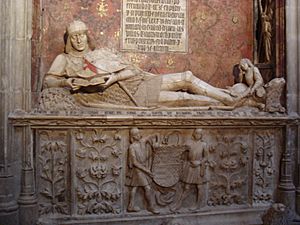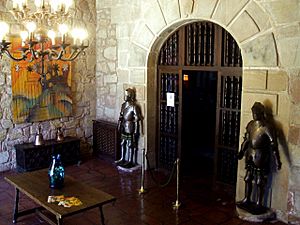Sigüenza facts for kids
Quick facts for kids
Sigüenza
|
|||||||||||||||
|---|---|---|---|---|---|---|---|---|---|---|---|---|---|---|---|
 |
|||||||||||||||
|
|||||||||||||||
| Country | |||||||||||||||
| Autonomous Community | |||||||||||||||
| Province | Guadalajara | ||||||||||||||
| Comarca | Serranía de Guadalajara | ||||||||||||||
| Towns (pedanías) |
List
Alboreca
Alcuneza El Atance Barbatona La Barbolla Bujalcayado Bujarrabal La Cabrera Carabias Cercadillo Cubillas del Pinar Guijosa Horna Imón Matas Mojares Moratilla de Henares Olmedillas Querencia Palazuelos Pelegrina Pozancos Riba de Santiuste Riosalido Sigüenza Torre de Valdealmendras Ures Valdealmendras Villacorza |
||||||||||||||
| Government | |||||||||||||||
| • Type | Mayor-council government | ||||||||||||||
| • Body | Ayuntamiento de Sigüenza | ||||||||||||||
| Area | |||||||||||||||
| • Total | 386.87 km2 (149.37 sq mi) | ||||||||||||||
| Elevation | 1,004 m (3,294 ft) | ||||||||||||||
| Population
(2018)
|
|||||||||||||||
| • Total | 4,356 | ||||||||||||||
| • Density | 11.2596/km2 (29.162/sq mi) | ||||||||||||||
| Demonym(s) | seguntino, -na; (es) | ||||||||||||||
| Time zone | CET (GMT +1) | ||||||||||||||
| • Summer (DST) | CEST (GMT +2) | ||||||||||||||
| Postcode |
19250
|
||||||||||||||
|
|||||||||||||||
Sigüenza is a historic city located in the Province of Guadalajara, in the Castile-La Mancha region of Spain. It is known for its beautiful old buildings and rich past. The city is often called seguntino or seguntina.
Contents
History of Sigüenza
The area where Sigüenza now stands was once home to an ancient town called Segontia. This town was built by the Celtiberians, an ancient group of people in Spain. It was located about half a league (a old unit of distance) from the modern city. The Roman writer Livy wrote about Segontia during the wars of Cato the Elder with the Celtiberians.
Changes in Rule
Over many centuries, Sigüenza was ruled by different groups. First, it was part of the Roman Empire. Then, the Visigoths, a Germanic people, took control. Later, it came under Moorish rule, which lasted for several centuries. Finally, it became part of the Kingdom of Castile, a Christian kingdom in Spain.
Medieval Times
Around the year 1123, a bishop named Bernard of Agen took control of Sigüenza. He became the city's first bishop. Sigüenza played an important role in the civil wars of the 1200s and 1300s. The strong palace of the bishops, which was originally a Moorish fortress, was captured in 1297. In 1355, Blanche of Bourbon, a queen, was held prisoner there.
The last bishop-lord, sometimes called the "mason-bishop," built a new part of the city in a fancy style. He later gave up his power over the city.
Modern History
During the Spanish Civil War (1936-1939), the castle was used by one side, while the cathedral was used by the other. Both buildings were damaged during this time. After the war, Sigüenza grew bigger by adding 28 nearby villages, called pedanías.
A Jewish community lived in Sigüenza from at least 1124 until 1492. This was when Jews were expelled from Spain. A famous scholar, Cardinal Jiménez de Cisneros, even learned Hebrew while he was in Sigüenza.
Main Sights to See
Sigüenza has many interesting old buildings and places to visit.
Sigüenza Cathedral
The Sigüenza Cathedral is a very large and impressive church. It is built in the Gothic style, which means it has tall arches and pointed windows. The lower parts of the cathedral show that it was built on top of an older Romanesque church.
The front of the cathedral has three doors and a fenced area. On each side, there are two tall square towers, about 164 feet high. These towers were built at different times and are connected by a decorative railing. Inside, the cathedral has a main area (called a nave) and two side areas (called aisles), all in the Gothic style.
The main altar area has a beautiful Renaissance altar. In another part of the church, called the transept, you can find the Chapel of Saint Liberata. She is the special saint of Sigüenza. This chapel has a decorated screen (called a reredos) and the saint's relics.
One of the most famous parts of the cathedral is the tomb of Martín Vázquez de Arce. He died in 1486 during a war. His brother had a statue made of him in alabaster (a soft, white stone). The statue shows him lying on his side and reading a book. It is a very famous piece of Spanish funerary art. People often call him the doncel de Sigüenza, which means 'the royal page of Sigüenza'.
The main room where priests prepare for services is called the "sacristy of the heads." It was designed in 1532. The ceiling of this room has 304 large heads and 2000 smaller ones carved into it. The cathedral's ceiling and stained glass windows were damaged during the Spanish Civil War but were repaired by 1947.
Connected to the cathedral is a beautiful Florid Gothic cloister, which is an open courtyard surrounded by covered walkways.
Sigüenza Castle
The Sigüenza Castle has a very long history, with parts dating back to the 5th century. The Moors made it bigger in the 8th century. In 1123, the Christians, led by Bishop Bernard of Agen, took it back.
In the late 1700s, a bishop changed the castle from a strong fortress into a grand palace. He added windows, balconies, and stables. However, in 1808, during the War of Spanish Independence, French soldiers captured the castle. They damaged it badly and took many valuable items.
After more damage from a fire in the 1830s, the castle was left empty. But in 1976, after a lot of repair work, it was opened as a Parador. A Parador is a luxury hotel, often in a historic building. The King and Queen of Spain visited in 1978 for its official opening. Today, its large lounge, once the castle's dining room, is decorated with banners and suits of armor.
Other Important Buildings
Sigüenza has other interesting old buildings:
- The Conciliar Seminary of San Bartolomé, built in 1651.
- The 12th-century Church of St James (Iglesia de Santiago).
- The ancient hermitage of Nuestra Señora, which was possibly the first main church.
- The Humilladero, a small Gothic hermitage that is now a tourism office.
- The convent of the Franciscans, known for its fancy Churrigueresque style.
University of Sigüenza
The College of San Antonio Portaceli in Sigüenza started in 1476. It was founded by Don Juan López de Medina, a church official. In 1483, the Pope gave permission for the college to offer courses in theology (the study of religion), canon law (church law), and the liberal arts (subjects like grammar, logic, and rhetoric).
In 1489, the college became a full university. It was given the power to give out degrees like bachelor, licentiate, and doctor. Later, new subjects like physics, secular law (non-church law), and medicine were added.
Many important scholars and church leaders taught at this university. For example, Pedro Ciruelo, a mathematician, helped make the university famous. Don Fernando Velosillo, a professor and leader of the university, was sent by King Philip II of Spain to an important church meeting called the Council of Trent.
The University of Sigüenza was very important in Spain during the late 1400s and early 1500s. However, its influence later declined, and it was closed in 1837. The university is even mentioned in the famous Spanish novel Don Quixote by Miguel de Cervantes.
Twin Towns
Sigüenza has friendly connections with two other towns:
- Sainte-Livrade-sur-Lot, France
- Vila Viçosa, Portugal
Images for kids
See also
 In Spanish: Sigüenza para niños
In Spanish: Sigüenza para niños
















